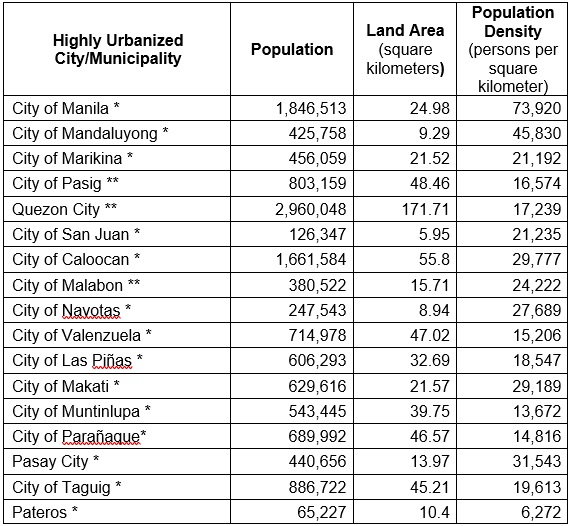NCR has 13.48 million total population in 2020
The population of the National Capital Region (NCR) as of May 1, 2020 is 13,484,462. Its population is higher by 607,209 from the population of 12.88 million in 2015, and 1,628,487 more than the population of 11.86 million in 2010. Moreover, it is higher by 3,551,902 compared with the population of 9.93 million in 2000. (Table 1)
Table 1. Total Population Based on Various Censuses:
National Capital Region

Source: Philippine Statistics Authority
The population of NCR accounts for about 12.37 percent of the Philippine population in 2020 which stands at 109,035,343 and among the 17 regions, NCR has the second highest population next to REGION IV-A (CALABARZON) with 16.19 million.
Nearly half of NCR population resides in Quezon City, City of Manila, and City of Caloocan
Among the 16 highly urbanized cities (HUCs) comprising NCR, Quezon City had the biggest population in 2020 with 2,960,048 persons, followed by the City of Manila with 1,846,513 persons, and the City of Caloocan with 1,661,584 persons. The combined population of these three cities comprises around 48.00 percent of the region’s population. This means that five out of ten persons in the region reside in Quezon City, City of Manila, and City of Caloocan.
The City of San Juan had the smallest population with 126,347 persons among the 16 HUCs while Pateros, the only municipality in the region, posted a population of 65,227 persons. (Table 2)
Table 2. Total Population by Highly Urbanized City/Municipality Based on Various Censuses: National Capital Region

Source: Philippine Statistics Authority
Barangay 176 in the City of Caloocan ranks first in the most populous barangays
Of the 1,710 barangays in NCR, 12 registered with more than 100 thousand total population in 2020. Barangay 176 in the City of Caloocan is the most populated with 261,729 persons followed by Commonwealth with 213,229 persons and Batasan Hills with 166,572 persons, both in Quezon City. (Table 3)
Table 3. Barangays with More Than 100,000 Population:
National Capital Region, 2020

Source: Philippine Statistics Authority
Annual Population Growth
NCR population increases at the rate of 0.97 percent annually
The population of NCR increased by 0.97 percent annually from 2015 to 2020. By comparison, the rate at which the population of the region grew from 2010 to 2015 was higher at 1.58 percent. (Table 4)
Table 4. Annual Population Growth Rate Based on Various Censuses:
National Capital Region

Source: Philippine Statistics Authority
City of Valenzuela is the fastest growing city in NCR
The City of Valenzuela was the fastest growing HUC in the region with an annual population growth rate (PGR) of 3.03 percent from 2015 to 2020. It was followed by the City of Mandaluyong with a PGR of 2.07 percent and the City of Taguig (2.06 percent). The City of Navotas posted the lowest PGR of -0.16 percent among the HUCs in the region.
Pateros, the lone municipality in NCR had a PGR of 0.45 percent. (Table 5)
Table 5. Annual Population Growth Rate by Highly Urbanized City/Municipality
Based on Various Censuses: National Capital Region

Source: Philippine Statistics Authority
Population Density
NCR is the most densely populated region.
With a 619.54 square kilometer land area, NCR is the most densely populated region with 21,765 persons per square kilometer. This figure is 60 times of the population density at the national level with 363 persons per square kilometer and 22 times than that of second highest region, REGION IV-A (CALABARZON), with 977 persons per square kilometer.
The population density of NCR increased by 4.72 percent or additional 980 persons per square kilometer from the 20,785 persons per square kilometer reported in 2015. The population density of NCR in 2010 was 19,137 persons per square kilometer.
City of Manila tops the list of most dense cities
Among the 16 HUCs in NCR, seven surpassed the regional population density of 21,765 persons per square kilometer. The City of Manila was the most densely populated with 73,920 persons per square kilometer in 2020, followed by the City of Mandaluyong with 45,830 persons per square kilometer, and Pasay City with 31,543 persons per square kilometer. The four other HUCs in NCR that surpassed the regional population density were the City of Navotas (27,689 persons per square kilometer), the City of Caloocan (29,777 persons per square kilometer), the City of Makati (29,189 persons per square kilometer), and the City of Malabon (24,222 persons per square kilometer). (Table 6)
Moreover, the City of Muntinlupa had the least population density among the HUCs in NCR with 13,672 persons per square kilometer.
Pateros, the only municipality in NCR, was the sixth most densely populated municipality in the country with 6,272 persons per square kilometer.
Table 6. Population Density of Highly Urbanized Cities:
National Capital Region, 2020

Source: Philippine Statistics Authority
Notes:
* Land area is based on cadastral survey (certified and provided to the DBM) from the LMB, DENR, as of December 2013.
** Estimated land area (certified and provided to the DBM) from the LMB, DENR, as of December 2013.
PACIANO B. DIZON
Regional Director
